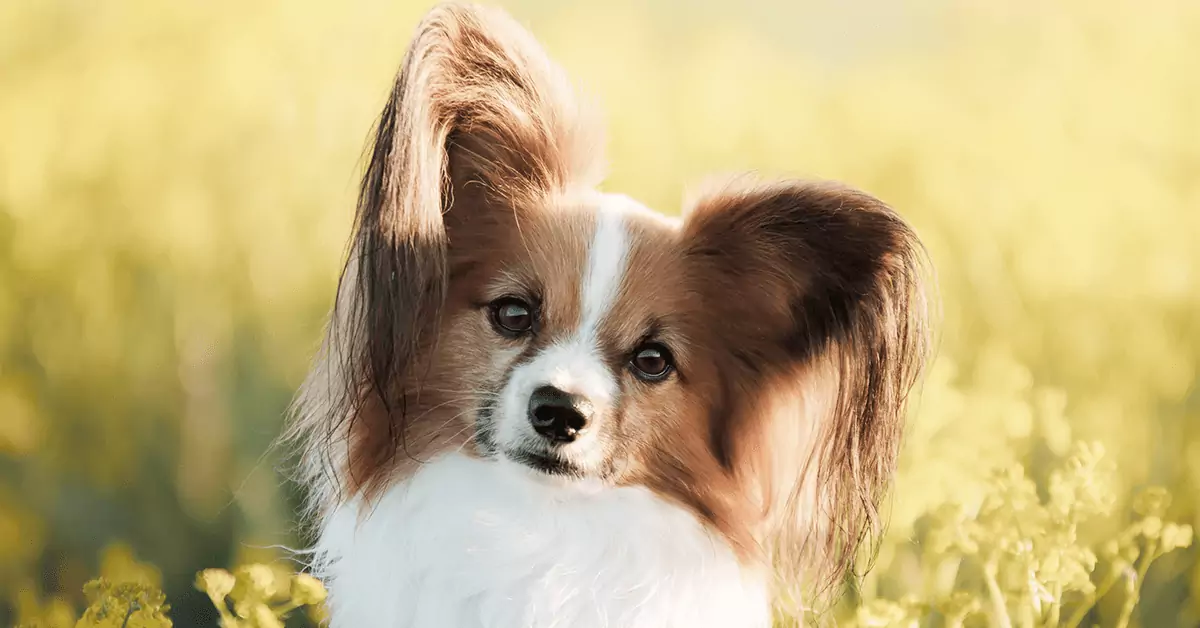
Meet the Papillon
High Doggy I.Q.
Star Athlete
Best Fur Friend
My Many Looks
My Breed Characteristics
Furbulous Fact
As I Grow Up
History of My Breed
Care Tips
Training Tips
Personality
Affectionate
Playful
Smart
Group
Toy
Origin
France
Life Span
14-16 Years
Breed Popularity
#53 of 195
Height Range
8-11 Inches
Weight Range
5-10 Pounds
Coat Details
Type
Long and Straight
Texture
Silky
Features
Colors
White & Black, White & Lemon, White & Red, White & Sable, White Blac
Hypoallergenic
Cost to Buy
$500-$1,900
Lifetime Care Cost
$17,650
My Many Looks
My Breed Characteristics
Furbulous Fact
As I Grow Up



History of My Breed
Care Tips
from Dr. Jessica Greenberg, Associate VeterinarianKeep an eye on your Pap’s puppy teeth.
Dogs with small mouths, such as the Papillon, can be predisposed to a condition known as retained deciduous teeth. This occurs when the growing adult tooth does not push the puppy tooth out of the way, leaving both teeth in the mouth. This can cause abnormalities in the dog's bite and in the wear of the teeth, as well as creating a pocket between the adult and puppy tooth where food debris can build up, allowing bacteria to grow and increasing the possibility of tooth root infection. Retained puppy teeth that do not come out on their own will need to be removed by a veterinarian.
Be on the lookout for signs of orthopedic trouble.
One of the most common orthopedic conditions Papillons face is patellar luxation, in which the kneecap is more mobile than it should be and moves outside of the taco-shaped groove in the knee, resulting in arthritis over time. Signs of a luxating patella can range from an intermittent "skipping" gait (where the dog picks up one of its hind limbs for a few steps while walking or running) to a crouching, bow-legged stance in severe cases. Anti-inflammatories, joint diets, and joint supplementation can be used in order to reduce pain and slow the progression of arthritis. In severe cases, surgery may be required.
Be aware of anesthesia sensitivity.
Because the Papillon is so small, they can be more sensitive to anesthetic procedures than their larger brethren. Their tiny bodies are more susceptible to hypothermia (severe drop in body temperature) and hypoglycemia (low blood sugar), and can therefore have a tougher recovery time after surgery. Careful surgical monitoring and preemptive warming are essential, and your veterinarian will want to keep surgical time to a minimum in order to help prevent these effects.
Training Tips
from Dr. Jessica Greenberg, Associate VeterinarianSocialize your Papillon early and often.
Like all small dogs, Papillons have a tendency to engage in reactive behaviors if not socialized properly. You absolutely need to expose your Papillon to many different people, dogs, places, and surfaces when they are young. Early socialization will ensure that your Papillon learns that these situations are fun and there is no reason to flip out.
Use soft toys to protect your Pap’s teeth.
Many Papillons really love fetch and even playing frisbee. Because of their small mouths and tendency to develop teeth issues, you should only use with soft frisbees and balls during playtime. Select specific cloth discs or balls made out of soft fabric for your Papillon's fetching fun.
Older Pap parents should train to avoid strain.
Because they are such small dogs, working with Papillons can be taxing on an owner's back. The constant bending to tend to the dog can lead to back pain, especially for older owners. A great way to combat this is to teach your Papillon early on to jump up on a stool or chair for you. That way you can easily put on their harness and collar, clip on a leash, or brush them without bending over.
My Many Looks
My Breed Characteristics
Furbulous Fact
As I Grow Up
History of My Breed
Care Tips
Training Tips
-
Personality
Affectionate
Playful
Smart
-
Group
Toy
-
Origin
France
-
Life Span
14-16 Years
-
Breed Popularity
#53 of 195
-
Height Range
8-11 Inches
-
Weight Range
5-10 Pounds
-
动物皮毛
Type
Long and Straight
Texture
Silky
Features
Colors
White & Black, White & Lemon, White & Red, White & Sable, White Blac
-
Hypoallergenic
-
Cost to Buy
$500-$1,900
-
Lifetime Care Cost
$17,650



